ABS CNC Machining: A Process That Turns Waste into Treasure
CNC machining not only involves the metal field, but is also widely applicable to the plastic field. ABS CNC machining is one of the common machining processes in several industries. The introduction of computer numerical control has made plastic processing and manufacturing processes more accurate, faster, and suitable for manufacturing parts with strict tolerances. In this article, we will help you learn more about ABS and the content and process of ABS CNC machining.
1.ABS definition
Acrylonitrile-butadiene-styrene copolymer (ABS): It has many advantages such as good heat resistance, aging resistance, and corrosion resistance of acrylonitrile (A), high toughness, impact resistance, and low temperature resistance of butadiene (B), and easy processing of styrene (S). ABS plastic has unique properties such as high strength, high toughness, impact resistance, heat resistance, low temperature resistance, and corrosion resistance.
2.ABS CNC Machining Definition
ABS parts belong to the common manufacturing process of plastic CNC machining services. Among many plastic materials, ABS is one of the easier ones to process. The entire process is controlled by a special computer program, using various CNC machine tools such as lathes, grinders, milling machines and milling machines. Then, according to the information indicated by the computer program, the material is subtracted from the workpiece, thus converting the raw material into the ideal ABS CNC machined product.
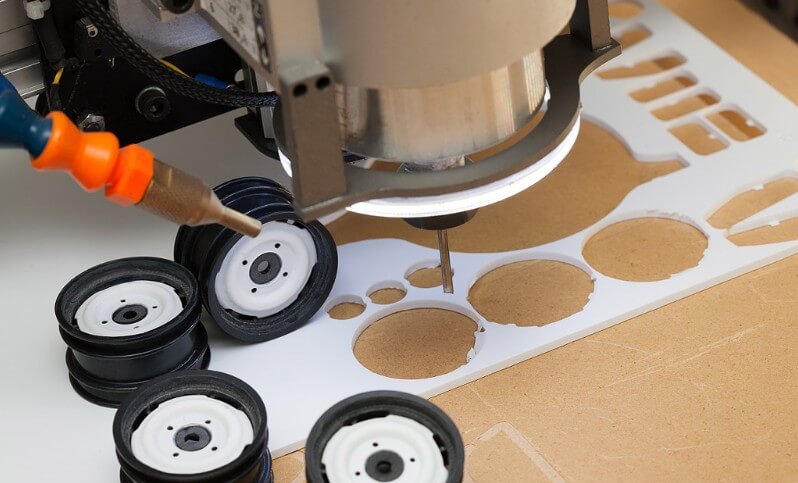
3.Applicable performance of ABS CNC machining
(1) Physical properties:
· Stronger toughness
· Impact resistance
· Corrosion resistance
· Thermal stability
· Moldable
· Recyclable
· Cost-effective
(2) Chemical properties:
Chemical formula: (C8H8)x (C4H6)y(C3H3N)z)
Injection temperature: (400 – 460 °F)
Liquidation temperature (glass transition): 105 °C (221 °F)
(3) Mechanical properties:
Heat deformation temperature: 0.46 °C (66 °F) at 98 MPa (208 PSI)
Toughness (cantilever beam notched impact at room temperature): 200 – 215 J/m
Yield elongation – 1.7-6%
Shrinkage – 0.5-0.7%
Flexural strength: 74 MPa (10800 PSI)
Shore Hardness D: 100
Elongation at break – 10-50%
Specific Gravity: 1.06
Tensile Strength: 46 MPa (6600 PSI)
(4) Electrical properties of ABS plastic:
Volume resistivity: 14 – 16 x 1015 ohm. cm
Arc resistance: 60-120 seconds
Dielectric constant: 2.7-3.2
Dissipation factor: 50 – 190 x 10-4
Dielectric strength: 15.7 -34kV/mm
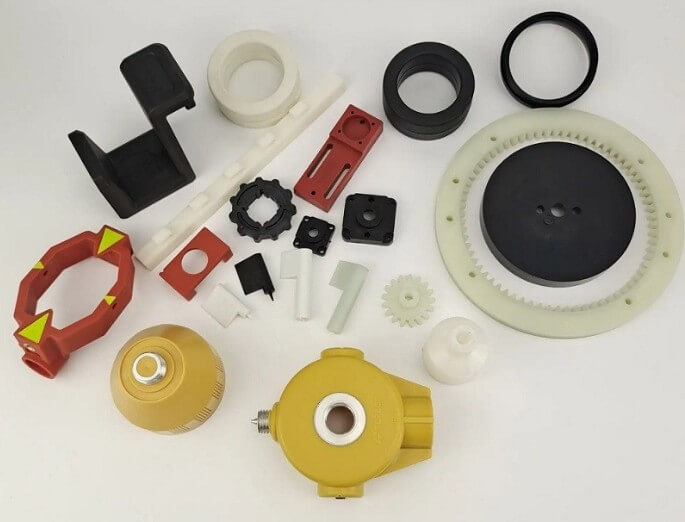
4.ABS CNC Machining Process
Below we discuss the step-by-step process of ABS CNC machining and provide a brief description of each process.
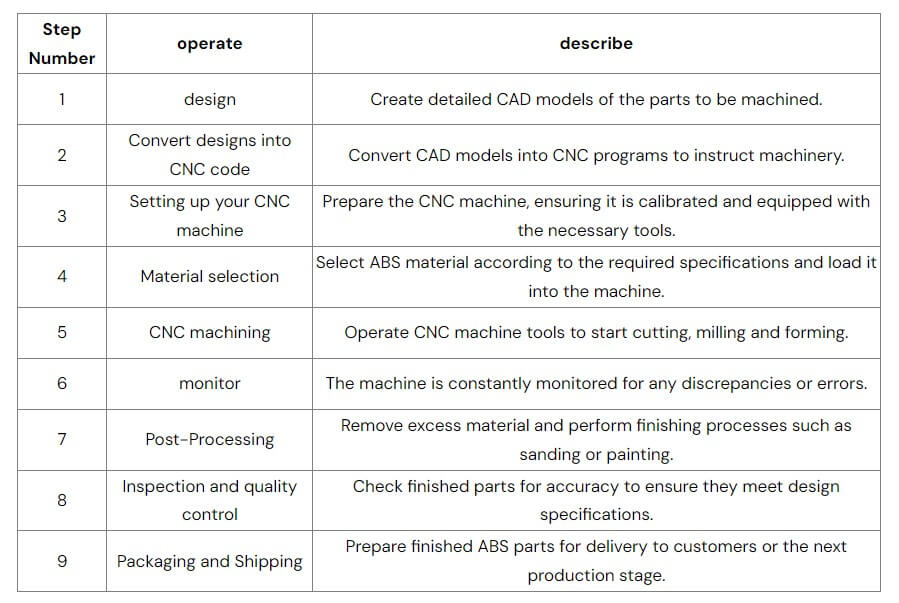
5.ABS CNC Machining Methods
(1) Milling ABS Plastic
Milling is often a common technique for ABS machining. This process helps carve out complex shapes and intricate details from ABS material. Milling achieves high precision, allowing manufacturers to achieve the exact geometry required for a part. During the milling process, a rotating tool removes material from the workpiece.
(2) Turning ABS on a Lathe
Turning ABS on a lathe is particularly suitable for producing cylindrical parts. In this technique, the ABS workpiece rotates and a single-point cutting tool removes material, improving the accuracy and surface finish of the part.
(3) Drilling and Tapping
Drilling and tapping are other important techniques in ABS machining. They help add functional features such as holes and threads. These processes are essential for assemblies that need to be assembled or merged with other parts.
(4) Engraving and Etching
Engraving and etching are techniques used to add text, logos, or complex designs to the surface of ABS parts. These methods enhance the aesthetics and functionality of components, making them suitable for a variety of applications, including signage, branding, or decorative purposes.
6.Advantages and Disadvantages of ABS CNC Machining
Advantages of ABS CNC Machining:
(1) Higher Accuracy
Since computer software controls the entire process, the manufactured parts of ABS CNC machining have higher precision and ensure manufacturing requirements.
(2) High Durability
Due to higher precision, the manufactured parts have higher durability. It automatically ensures the long-term performance of the components.
(3) Rapid Mass and Prototype Production
ABS CNC machining is the fastest way to produce ABS plastic prototypes. Since the prototype is made quickly, it helps to quickly mass produce.
(4) Create parts with complex geometries
ABS products produced by CNC machining process have complex geometries, and their parts show higher accuracy and precision.
(5) Excellent Surface Finish
This helps provide an excellent and smoother surface finish at the end of machining without the need for additional surface preparation processes.
(6) High Cost Performance:
ABS CNC machining is a cost-effective process that does not require the creation of expensive molds, thus saving on production costs.
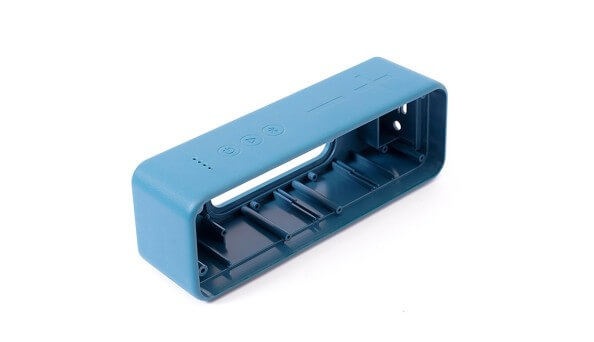
Disadvantages of ABS CNC machining:
(1) Large amount of waste generated
The main disadvantage of ABS CNC machining is that it generates a lot of waste.
(2) High equipment cost
The cost of CNC machining is high. Therefore, a lot of money must be spent to manufacture ABS parts.
7.ABS CNC Machining Applications
ABS can be transformed into parts required by different industries, including automobiles, electronics and electrical, aerospace, home appliances, defense, toys, etc.
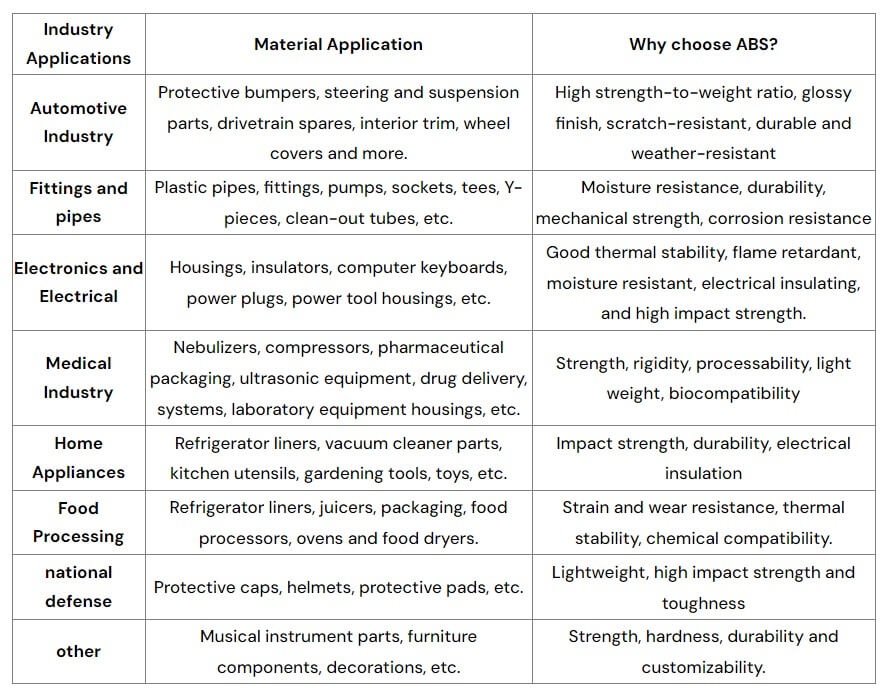
8.Summary
ABS CNC machining combines modern manufacturing capabilities with the excellent quality of ABS plastic. This fusion produces parts that meet the highest standards of durability, functionality and aesthetics. Whether you want to make prototypes or mass production, it is important to understand the technology, cost and advantages of ABS CNC machining.
If you are looking for an experienced CNC machining manufacturer, Xavier is your ideal choice. The Xavier team is well-equipped to provide high-quality CNC machining solutions. If you need more information or to discuss your machining needs with us, please feel free to contact us.
